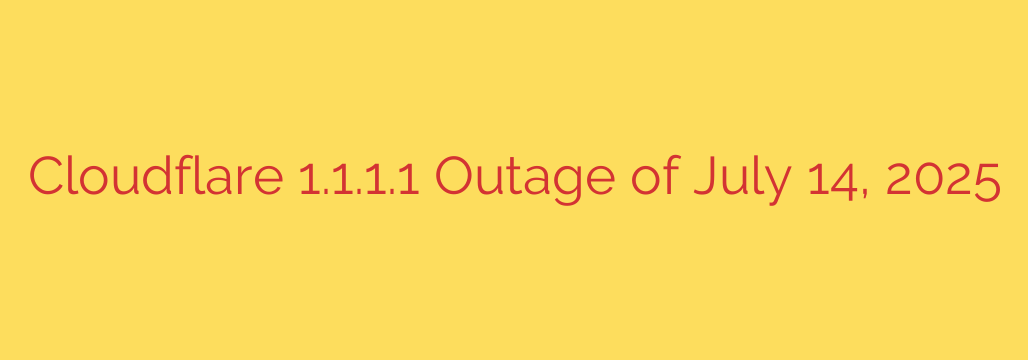
Understanding the Recent 1.1.1.1 Resolution Issues and How to Stay Protected
On July 14, 2025, many users experienced difficulty accessing websites and online services. This disruption stemmed from issues affecting the widely used 1.1.1.1 DNS resolver. While the outage was relatively brief, it served as a stark reminder of the internet’s reliance on a stable DNS infrastructure. Let’s delve into what happened and, more importantly, what you can do to mitigate the impact of future DNS-related disruptions.
What happened on July 14th, 2025?
The primary issue revolved around problems resolving domain names using the 1.1.1.1 DNS resolver. In simpler terms, the system that translates website addresses (like example.com) into numerical IP addresses that computers understand experienced difficulties. This resulted in users being unable to connect to websites, even if their internet connection was working perfectly. The root cause, according to initial reports, was a complex interaction of newly implemented network optimization protocols that inadvertently created resolution bottlenecks under peak traffic load.
Why is 1.1.1.1 so important?
1.1.1.1 is a public DNS resolver known for its speed and privacy features. Many individuals and organizations configure their devices to use it as their primary DNS server, aiming for faster and more secure browsing. This widespread adoption is what made the disruption so impactful – a significant portion of internet users were affected simultaneously.
How did this impact users?
The effects ranged from slow loading times to complete website unavailability. Online gaming, streaming services, and other latency-sensitive applications also suffered. Businesses relying on online transactions faced potential revenue losses, and internal communication systems could have been disrupted.
What can you do to protect yourself from future DNS outages?
While you can’t directly fix a problem with a major DNS resolver, you can take steps to minimize the impact on your own internet experience. Here are a few actionable tips:
Use multiple DNS resolvers: Don’t rely solely on one DNS resolver. Configure your devices (routers, computers, and smartphones) to use a secondary DNS server. Popular alternatives include Google Public DNS (8.8.8.8 and 8.8.4.4) and Quad9 (9.9.9.9). Having a backup ensures that if one resolver fails, your device can still resolve domain names.
Understand your router settings: Familiarize yourself with your router’s configuration interface. This is where you’ll typically find the DNS settings. Check your router’s manual or your ISP’s support website for specific instructions.
Consider a local DNS cache: Advanced users might explore setting up a local DNS cache on their computers or network. This stores recently resolved domain names, allowing for even faster access to frequently visited websites, even if the primary DNS server is temporarily unavailable. Tools like
dnsmasqcan help with this.Stay informed: Keep an eye on reputable tech news sources and social media channels for updates on major internet outages. Knowing about a problem can help you understand why you’re experiencing connectivity issues.
Monitor DNS resolution: For businesses and organizations, consider implementing DNS monitoring tools to proactively detect and respond to DNS resolution problems before they significantly impact users.
Moving Forward
The 1.1.1.1 outage serves as a reminder of the inherent fragility of the internet infrastructure. By understanding the role of DNS and taking proactive steps to diversify your DNS resolvers and stay informed, you can significantly improve your resilience against future disruptions and ensure a more reliable online experience. Remember, a little preparation can go a long way in keeping you connected.
Source: https://blog.cloudflare.com/cloudflare-1-1-1-1-incident-on-july-14-2025/








